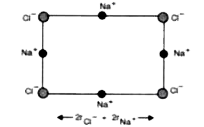What is the C.N of Cl− ions in NaCl crystals ?
To determine the coordination number (C.N) of Cl⁻ ions in NaCl crystals, we can follow these steps:
Step 1: Understand the Structure of NaCl
NaCl crystallizes in a face-centered cubic (FCC) lattice structure. In this structure, the sodium ions (Na⁺) occupy the octahedral voids, while the chloride ions (Cl⁻) form the lattice points.
Hint: Remember that in ionic crystals, cations and anions occupy specific positions in the lattice.
Step 2: Identify the Position of Ions
In the NaCl structure:
- Na⁺ ions are located at the octahedral voids.
- Cl⁻ ions are located at the corners and face centers of the cubic unit cell.
Hint: Visualize the cubic structure to see where each ion is located.
Step 3: Coordination Number of Na⁺
The coordination number of an ion is defined as the number of nearest neighbors surrounding that ion. For Na⁺ in the octahedral void, it has 6 Cl⁻ ions as its nearest neighbors.
Hint: Count how many Cl⁻ ions surround each Na⁺ ion.
Step 4: Charge Ratio
The charge ratio of Na⁺ to Cl⁻ is 1:1, which means for every Na⁺ ion, there is one Cl⁻ ion.
Hint: The charge ratio can help confirm the coordination number relationship.
Step 5: Coordination Number of Cl⁻
Since the coordination number of Na⁺ is 6, and the charge ratio is 1:1, the coordination number of Cl⁻ will also be 6. This means each Cl⁻ ion is surrounded by 6 Na⁺ ions.
Hint: Use the established relationship between the coordination numbers of cations and anions based on their charge ratio.
Conclusion
Thus, the coordination number of Cl⁻ ions in NaCl crystals is 6.
Final Answer: The coordination number (C.N) of Cl⁻ ions in NaCl crystals is 6.
---
NaCl crystallizes in a face-centered cubic (FCC) lattice structure. In this structure, the sodium ions (Na⁺) occupy the octahedral voids, while the chloride ions (Cl⁻) form the lattice points.
In the NaCl structure:
- Na⁺ ions are located at the octahedral voids.
- Cl⁻ ions are located at the corners and face centers of the cubic unit cell.
The coordination number of an ion is defined as the number of nearest neighbors surrounding that ion. For Na⁺ in the octahedral void, it has 6 Cl⁻ ions as its nearest neighbors.
The charge ratio of Na⁺ to Cl⁻ is 1:1, which means for every Na⁺ ion, there is one Cl⁻ ion.
Since the coordination number of Na⁺ is 6, and the charge ratio is 1:1, the coordination number of Cl⁻ will also be 6. This means each Cl⁻ ion is surrounded by 6 Na⁺ ions.
Thus, the coordination number of Cl⁻ ions in NaCl crystals is 6.
Similar Questions
Knowledge Check
If the distance between Na+ and Cl− ions in NaCl crystals is 265 pm, then edge length of the unit cell will be ?
A265 pmB795 pmC132.5 pmD530 pmThe distance between Na+ and Cl− ions in NaCl with a density 3.165gcm−3 is
A497 pmB248.5 pmC234 pmD538.5 pm
What is the C.N of Ca2+ and F− ions in CaF2 crystal lattice ?
View SolutionA cubic unit cell contains manganese ions at the corners and fluoride ions at the centre of each face.
(a) What is the empirical formula ? (b) What is the C.N. of Mn2+ ion ?
(c) Calculate the edge length of the unit cell if the radius of Mn2+ ion is 0.65Å and that of F− ion is 1.36Å.
View SolutionS1: Distance between Na+ & Cl− in NaCl crystal is more than half of edge length.
S2: The no. of triangular viods in the given arrangement in the enclosed region is 3
S3: In ZnS structure, 2Zn2+ & 2S2− ions are present in each unit cell
View SolutionIn NaCl crystal the Cl− ions are in f.c.c. arrangement. Calculate the number of Cl− ions in unit cell.
View SolutionStatement-1 C.N of Cs+ ion in CsCl structure is 8
Statement -2 CsCl crystallizes in BCC structure
View SolutionA : In NaCl coordination number of Cl− ion is 6 but in CsCl coordination number of Cl− ion is 8.
R : Ionic radii changes with type of lattice.
View Solution

